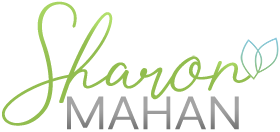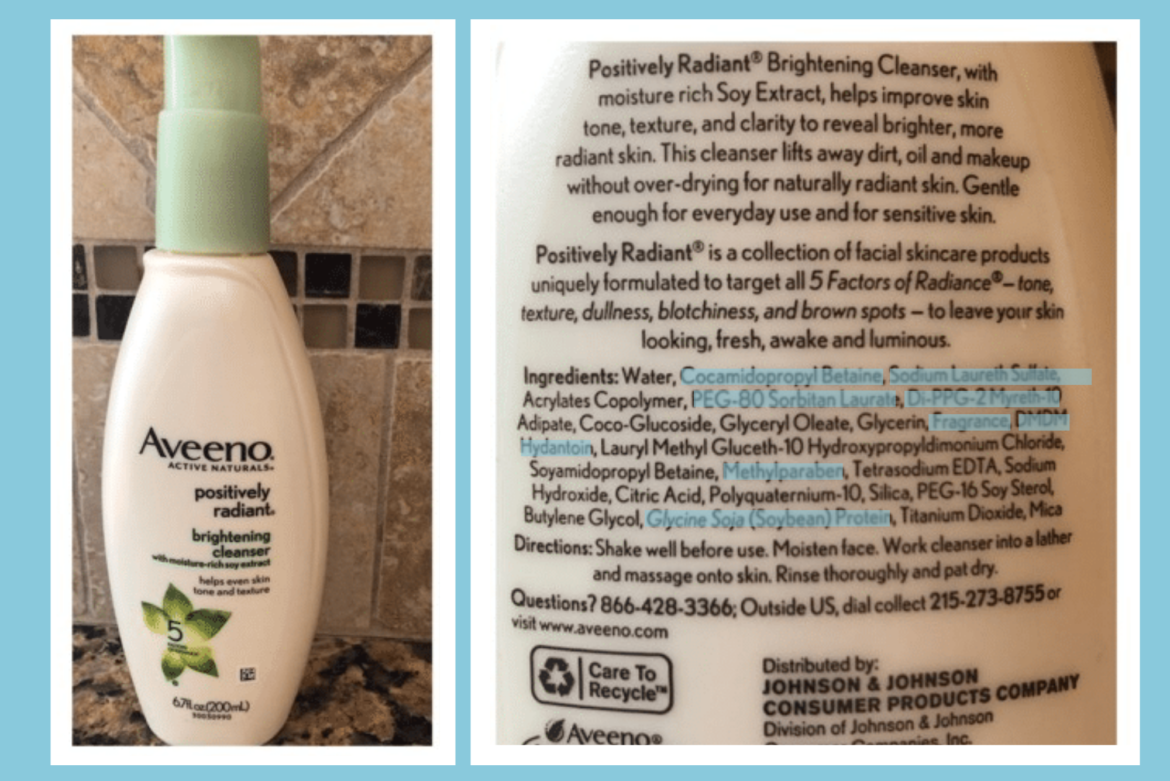It takes a lot to surprise me these days, but I must say that this naturally branded product made my blood boil.
When talking about switching to safer options, people often tell me, “Oh, well I use Aveeno®. That’s better, right?” The sad truth is that it’s really not much better than anything else you can purchase at a grocery store or your local Target.
That much I knew for sure.
But then this bottle fell into my hands for my “Tox Box”.
My Tox Box is a basket of personal and home care products I use to demonstrate that everyday items are filled with harmful ingredients. I take the top offenders from the BACK of the bottle, and display them prominently on the FRONT.
This Aveeno® Active Naturals® Positively Radiant Brightening Cleanser contains 20+ ingredients. And only *ONE* is even remotely “natural”.
That one ingredient is soy … nearly 100% of which is genetically modified in the US.
Even if it’s non-GMO, soy still remains a concern for women at risk for hormone-receptive cancers. But that’s a story for another day.
The soy, however, is far from my only gripe with this product. The attractively packaged bottle contains some of the WORST offenders when it comes to ingredients.
Let’s take a look at those that are most concerning:
Water
While obviously not itself an ingredient of concern, it bears noting that water is a breeding ground for bacteria. Generally speaking when water is the first ingredient, you’re also going to find one or more potent antimicrobial agents, which may damage or kill the beneficial bacteria that reside on your skin.
Cocamidopropyl Betaine
This is a surfactant, which is a foaming agent that break the surface tension of liquids, making them slippery and giving them functionality as a detergent. They’re found in liquid soaps, cleansers, shampoos and toothpastes. Cocomidopropyl betaine has been associated with irritation and allergic contact dermatitis. Even more concerning is that based on the way this chemical is formulated, it’s known to be contaminated with nitrosamines, which are a known carcinogen.
That means it can cause cancer in living tissue.
Download Sharon's FREE Label Reading Guide
Sodium Laureth Sulfate (SLES)
Most surfactants are by nature somewhat irritating, which is why people who wash their hands frequently end up with dry, cracked skin on their hands. Scientists discovered that by manipulating the molecules that make up the most widely used surfactant, sodium lauryl sulfate, they could create a more gentle ingredient. Similar to the process of creating cocamidopropyl betaine, SLES creates a contamination concern. SLES may be contaminated with ethylene oxide and 1,4-dioxane, both known carcinogens.
PEG-80 Sorbitan Laurate
Polyethylene Glycols (PEGs) are widely used petroleum byproducts that – like SLES – carry a contamination concern of Ethylene Oxide and 1,4-dioxane. PEGs are widely used as thickeners, solvents, softeners, and moisturizing agents, and as a cosmetic cream base. Certain PEGs also function as a laxative. Take a look at a bottle of MiraLAX ®(r) and you’ll see that it’s nothing more than a bottle of polyethylene glycol powder.
Di-PPG-2 Myreth-10 Adipate
The EWG Skin Deep database reports this ingredient in 10 products and ranks it a 1 (Low Hazard) however this is based on a complete absence of safety data.
Check out this post for more information on the limitations of the EWG Skin Deep database.
Fragrance
Protected under trade secret labeling laws, this ‘ingredient’ is of high concern in that it may contain an untold number of otherwise undisclosed chemicals. A large majority of products with “fragrance” contain phthalates (which are linked to male reproductive birth defects and low sperm count) and other industrial chemicals lacking extensive safety profile.
DMDM Hydantoin
Used as a preservative, this ingredient is a formaldehyde releaser and is known to cause sensitization after repeated exposure.
Methylparaben
One of several parabens with strong evidence of human endocrine disruption. Parabens interfere with gene expression and are of high concern for women at risk for estrogen related cancers.
Glycine Soja (Soybean) Protein
Generally regarded as low concern; however soy has estrogenic effects and may be problematic for women at risk for estrogen related breast cancer.
Moral of the story … the large majority of attractively packaged products contain harmful chemicals. Everything on the front of the bottle is designed to facilitate a sale. Take the time to turn the bottle around and read the ingredients, because after all, it’s ALL about the ingredients!
Not feeling confident about your ability to read a label? Download my FREE Label Reading Guide to get started! Then join my Toxic Free Friends community on Facebook and post your questions there. We got peeps who will help you out!

